The ‘Constitution State’ has a central valleys, mountains, and coastal lowlands which makes for a pretty diverse set of environments when it comes to Avian species. Today we’ll discuss some of the popular backyard birds of Connecticut so that you can get the scoop on a few of the birds which you can see here, as well as where they lurk, what they like to eat, and some great places where you can go to see them in the wild. Let’s chitchat about the beautiful birds of Connecticut!
3 Categories – 280 Birds
Connecticut is a part and full time home to somewhere in the neighborhood of 280 different species of birds. This is great news for Connecticut birders and to start things off on our mini bird-tour we’re going to introduce you to a few feathered friends you can meet here and divide them up like this:
- Year-round Resident birds
- Birds of Spring, Summer, and Early Fall
- Fall and Winter Birds
After we give you a crash-course in these birds you’ll have some good information to help you to locate them on your own or possibly lure them over to you. Let’s start with the year-round resident birds.
Connecticut’s Year-round Resident birds
These birds are to be found at any time of the year in the Constitution state, especially when you know where to look. See if you can spot on of these year-round resident birds this year:
- Dark-eyed Junco
- Northern Cardinal
- Black-capped Chickadee
- American Robin
- Red-bellied Woodpecker
Dark-eyed Junco – Junco hyemalis

Coloration and Markings: Dark-eyed Juncos had dark gray or brown backs with medium-length wings and long, gray or brown tails with white edges and undersides. The underbelly and breast of this bird are white, with a heavy flanking of gray or brown on the sides which grows thicker as the color approaches the breast. Facially, this bird will be dark gray or brown with a medium-length conical pink bill.
Size: This bird measures in at 5.5 – 6.3 inches in length and has a wingspan of 7.1 to 9.8 inches.
Habitat: When it’s warm, Juncos prefer coniferous or mixed coniferous woods, ranging out (especially in winter) to visit overgrown fields, parks, and the occasional backyard.
Diet: Hulled Black Oil Sunflower seeds, White Proso millet, and cracked corn are 3 favorites of the Dark-eyed Junco.
Northern Cardinal – Cardinalis cardinalis
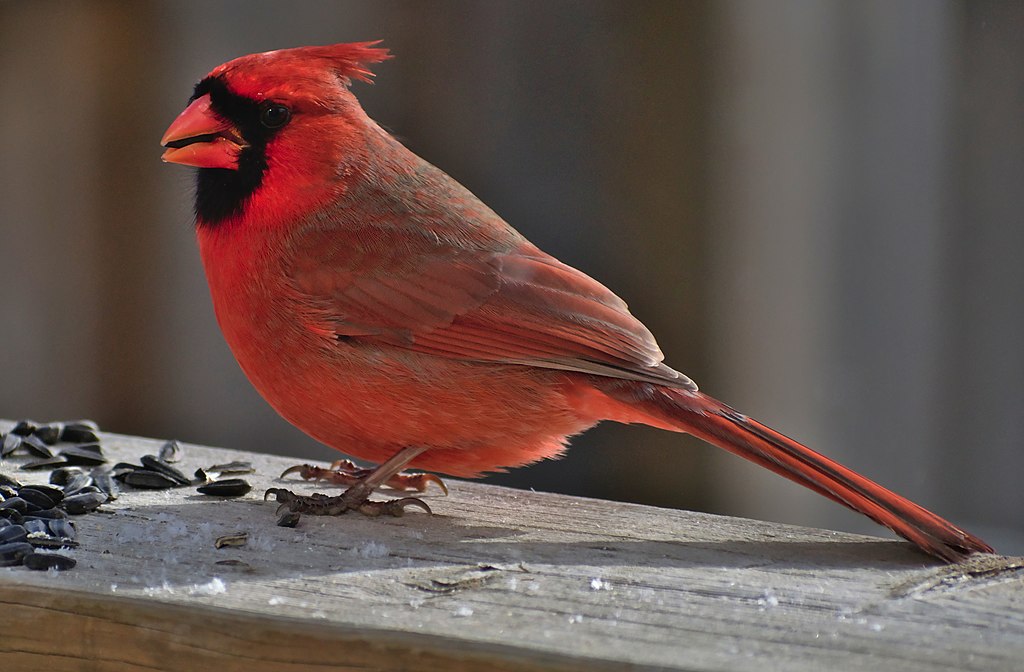
Coloration and Markings: Male Northern Cardinals are striking and one of the easiest birds to identify. They are completely red, with the occasional exception of grayish-brown feathers when they are molting. They have medium-length wings and long tails and facially, these birds have a black mask that covers the eyes and carries down onto the chin, and a majestic red crest that you won’t forget seeing. These birds have medium-length, conical reddish-orange bills. Female
Cardinals will be light brown in color overall, with tiny splashes of red throughout their plumage.
Size: These birds measure in at 8.3 – 9.1 inches in length and have wingspans of 9.8 to 12.2 inches wide.
Habitat: When they aren’t spending time at the forest edge these birds may be commonly found in places like woodlots, thickets, parks, and backyards.
Diet: White milo and Safflower seeds are a winning combination when it comes to Northern Cardinals.
Give it a try and see for yourself!
Black-capped Chickadee – Poecile atricapillus
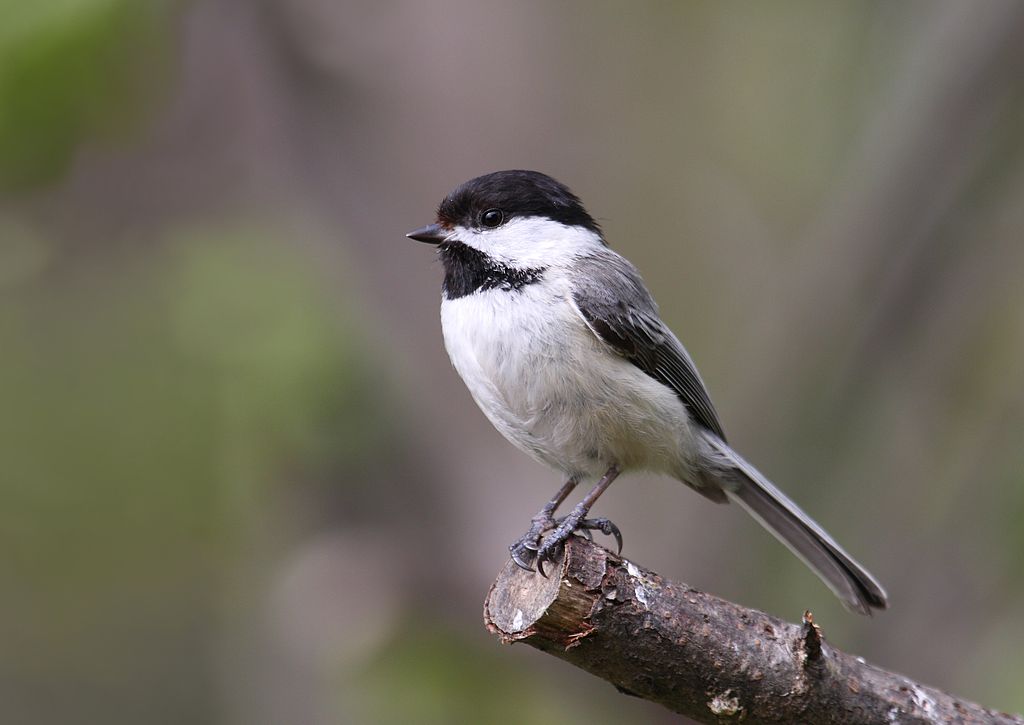
Coloration and Markings: Black-capped Chickadees have gray backs with small, gray wings, which present a lot of white edging. They have long, gray tails, which are edging in white as well and the underbelly and breast of this bird are white with faint tan flanking. Facially, these birds have a small, black bib as well as a large, black cap. This cap terminates at about mid-eye level, with the center of the face being a snowy white. These birds have small, conical black bills.
Size: These birds measure in at 4.7 – 5.9 inches in length and have wingspans of 6.3 to 8.3 inches in width.
Habitat: These birds love dense cover, such as shrubs, thickets, brambles, and thorns. If there are also some trees nearby then they love it even more. You can also spot Chickadees in places like overgrown fields, marshes, and the occasional backyard with a well-stocked feeder.
Diet: Suet and Black Oil Sunflower seeds are all that you need to make a Black-capped Chickadees happy.
American Robin – Turdus migratorius
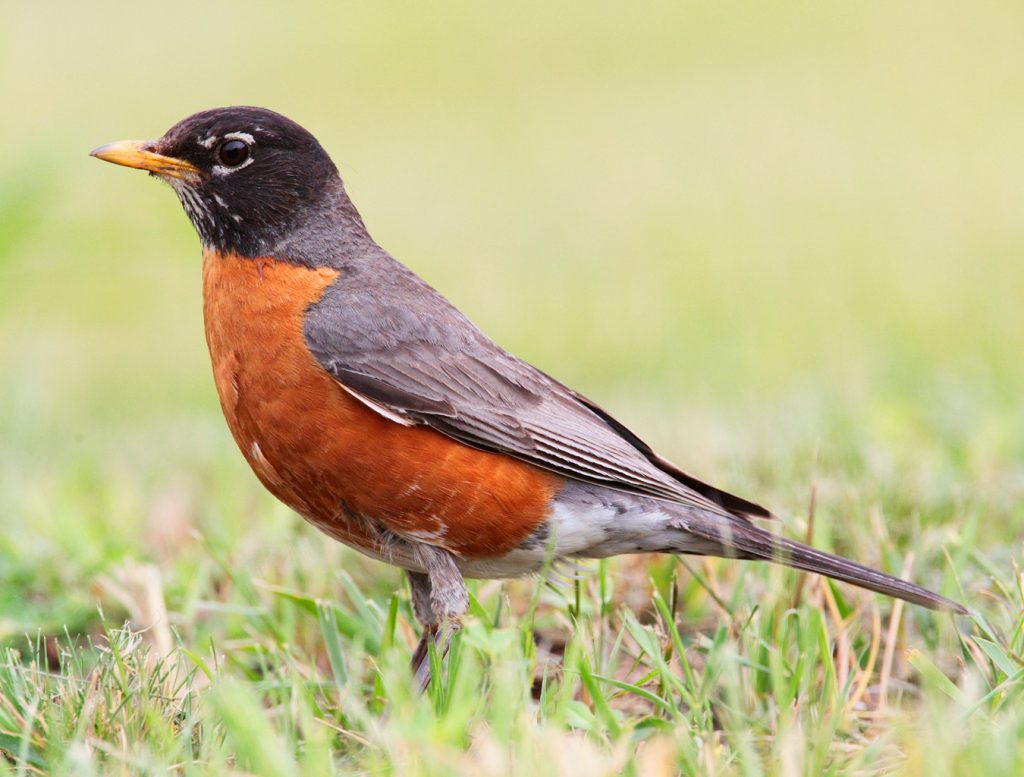
Coloration and Markings: American Robins have dark grayish-brown backs, with long wings and a long tail, which is white on the undersides and edges. These birds have a white rump and their underbelly and breast will be a dark tangerine-orange color. Facially, Robins have black heads with ‘broken’ pieces of a white around each eye. These birds have medium-length, lightly curved yellow bills.
Size: These birds measure in at 7.9 – 11 inches from tip to tail and have wingspans of 12.2 to 15.8 inches wide.
Habitat: While fond of Pine forests and deciduous woods, these birds may also be found in a variety of other locales. Don’t be surprised to see Robins foraging in the snowy tundra, in the pasture at a far, or simply scoping you out from a fence or phone line. These bold birds go where they like.
Diet: Robins aren’t so keen on birdseed, but you can get their attention with mealworms or fruits. Try leaving out some chopped apples and dry or live mealworms and you might just get their attentions.
Red-bellied Woodpecker – Melanerpes carolinus

Coloration and Markings: Red-bellied Woodpeckers have amazing zebra-striped back, as well as long wings, and short, stiff tails with stripes as well. The underbelly and breast of this bird are white, but with a red spot at the underbelly and splashes of faint red throughout the rest. Facially, these birds have red-splashed cheeks on their white faces and a red cap that extends down to the nape of the Woodpecker’s neck. These birds have long, stout, and straight black bills.
Size: These birds measure in at approximately 9.4 inches from tip to tail and have wingspans of 13 to 16.5 inches wide.
Habitat: These birds spend a lot of time in the woods, especially around trees like Pine, Oak, and Hickory. They range out often, however, and are frequent visitors to parks and backyards.
Diet: These little omnivores eat everything, sampling insects, frogs, small fish, and more in the wild. They also have a sweet tooth, so to get their attentios try leaving out some suet mixed with crunchy peanut butter. Don’t be surprised if they wash it down with a drink from your Hummingbird feeder, either!
Connecticut’s Birds of Spring, Summer, and Early Fall
The air starts to seem hazy as the Red Maples bring out their blooms and before you know it, spring birds start arriving and more birds keep coming until it’s time to move on in the early fall. See if you can spot one of these birds during the warmer months:
- Red-eyed Vireo
- House Wren
- Cedar Waxwing
- Red-winged Blackbird
- Tree Swallow
Red-eyed Vireo – Vireo olivaceus
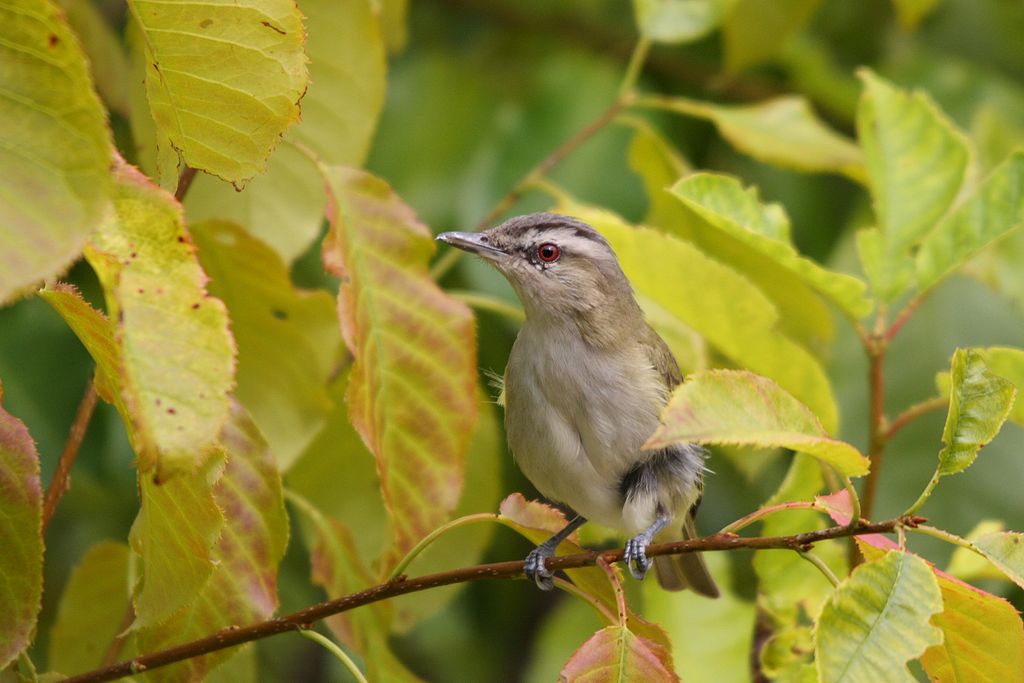
Coloration and Markings: Red-eyed Vireos have yellowish-green backs, with medium-length wings and short tails which are gray and yellowish green as well (with yellowish green underneath the tail as well!). They have a white breast and underbelly, with a thin flanking of yellow-green color just under the wings, and the white from the breast carries up into the chin. The remainder of the bird’s face is olive colored, with the exception of an olive eyestripe with a small amount of white under and over-lining it, as well as an ‘angry’ angled black eyebrow line and a small, gray crown. This bird has a medium length, straight black and gray bill with a tiny hook at the tip. Note, only adult Vireos will have red eyes, with juveniles displaying black ones.
Size: These birds measure in at 4.7 – 5.1 inches from head to tail and have wingspans of 9.1 to 9.8 inches wide.
Habitat: Red-eyed Vireos love deciduous woodlands and are particularly fond of Maple trees. In the warmer months they can be found just about any type of woods and in local woodlots.
Diet: These birds eat insects primarily but they also supplement their diets with fruit. They are especially fond of oranges, so try leaving out a half orange in your feeder or nailed to a tree to get this bird’s attention.
House Wren – Troglodytes aedon
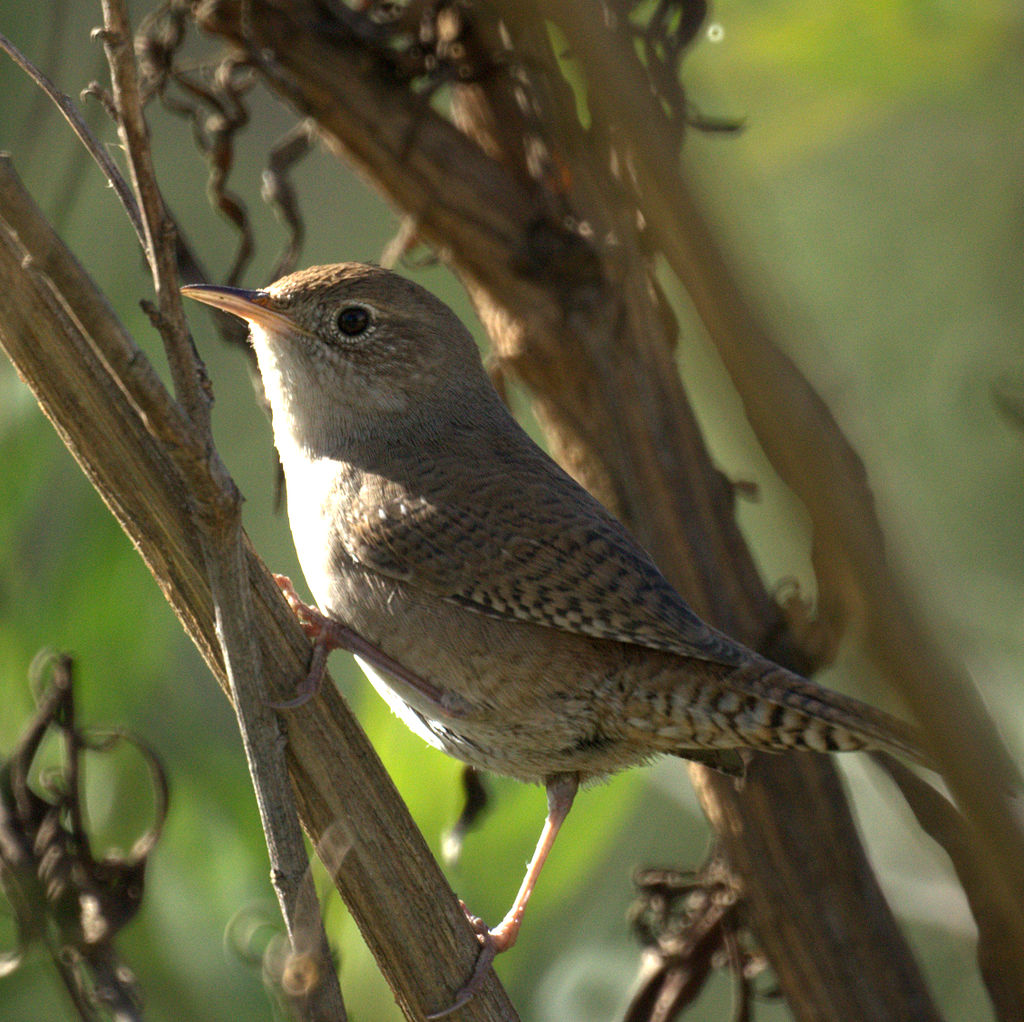
Coloration and Markings: House Wrens are plump little birds with dark brown backs and small wings and a medium length tail, displaying banded, checkerboard-like patterns of minute white and brown blocks. The underbelly and breast display this too, though it is lighter, and they have lighter colored throats as well which have minute, white streaking on brown. This is also reflected in the face and you will also notice a thin, white eyebrow line. These birds have long, thin black bills with the occasional splash of brown and a minute curvature present on the upper bill.
Size: These diminutive birds measure in at 4.3 – 5.1 inches in length and have wingspans of approximately 5.9 inches.
Habitat: These birds love open wooded areas with high weeds and grasses, but they range out often to visit farms and parks as well as backyards with well-stocked feeders.
Diet: Suet, crunchy peanut butter, and live mealworms are all great for attracting the House Wren to your backyard feeder.
Cedar Waxwing – Bombycilla cedrorum
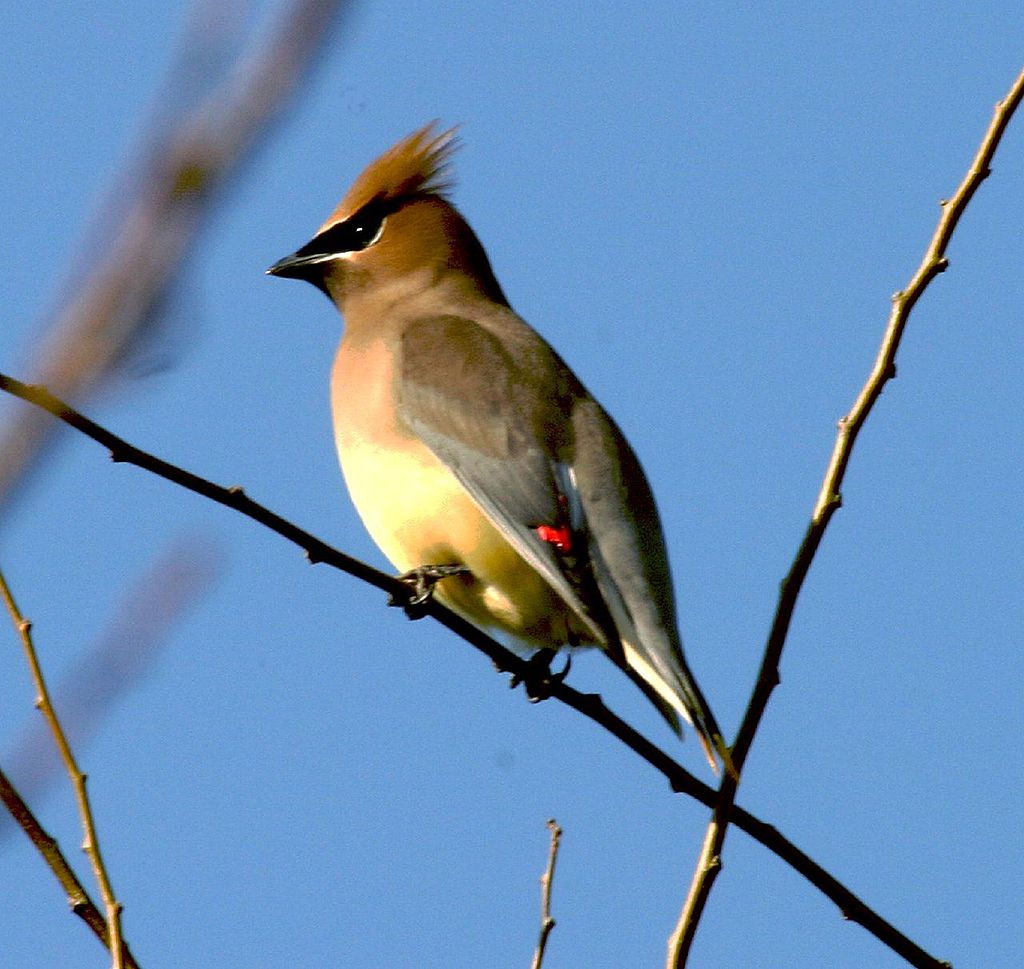
Coloration and Markings: Cedar Waxwings have a brown upper back with the rest being a soft gray. They have broad, medium-length wings which are brown at the shoulders but mostly gray aside from this, with the exception of a pan-flute style arrangement of waxy, red lines at mid-wing and darker gray tips. These birds have short, stocky tails which are gray with yellow tips and a line of black above the yellow. They have white rumps and the underbelly of this bird is white and yellow while the breast is white with brown mixed in. You will also see a denser brown coloration making a v-shape into the top of the breast coming from the bird’s face. Facially, this bird is mostly brown, with a black mask which has white above and below close to the bill, and the mask terminates beyond the eyes after curving up to the end of lovely, brown crest. These birds have short, stocky, triangular black bills.
Size: These birds measure 5.5 – 6.7 inches from head to tail and have wingspans of 8.7 to 11.8 inches wide.
Habitat: When they aren’t in the woods, these birds are quite often found in orchards, farms, and suburban backyards.
Diet: In the wild these birds like to eat insects and flower petals, but they also supplement their diets with berries. Leave out some whole blueberries or chopped cherries and you might just get the Cedar Waxwing’s attention.
Red-winged Blackbird – Agelaius phoeniceus

Coloration and Markings: Male Red-winged Blackbirds have some excellent coloration, being almost completely black with a few lovely exceptions. They have long wings and long, flared tails, and on the shoulder of the wings you will see red and yellow shoulder badges, with red being the larger color patch of color. When the bird is at rest, the red resembles a shark fin on a yellow sea, and on the wings and back you can see threadlike traces of red and yellow patterning. Aside from this, the rest of the body is black and this bird has a long, sharp, conical black bill.
Size: Roughly Robin-sized, these birds measure in at 6.7 – 9.1 inches in length and have wingspans of 12.2 to 15.8 inches wide.
Habitat: These birds love to be near water, in the form of ponds, marshes, or even water traps at the gold course. You can also see them sometimes in overgrown fields, feedlots, pastures, and meadows, and they do venture occasionally into backyards with feeders.
Diet: Suet and Black Oil Sunflower seeds are an easy combination for attracting the Red-winged Blackbird.
Tree Swallow – Tachycineta bicolor
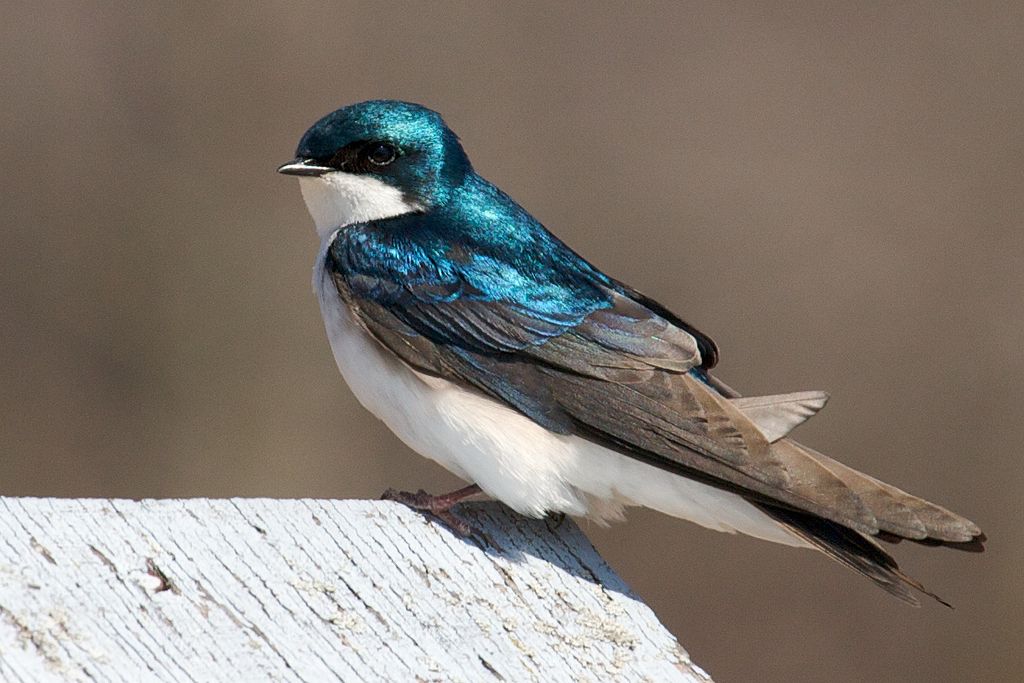
Coloration and Markings: Adult male Tree Swallows have dark blue or green blue backs, with the color displaying in scale-like patterns. They have long, dark gray wings and short wide notched gray tails. The underbelly and breast of this bird are a snowy white which continues up to the chin and cheeks to take up the lower face of this bird. The remainder of the face will be deep, dark blue or blue-green and this bird has a black mask which extend a bit under the eye as well as through it, terminating just above and behind the eyes. These birds have very tiny, triangular black bills.
Size: These birds measure in at 4.7 – 5.9 inches in length and have wingspans of 11.8 to 13.8 inches in width.
Habitat: These birds love open, weedy fields, especially those are prone to flooding. They also tend to stay close to marshes and ponds whenever possible.
Diet: Hulled Black Oil Sunflower seeds, chopped apples, and live mealworms are all 3 favorites of the Tree Swallow that can help to lure them in for a closer look.
Connecticut’s Fall and Winter Birds
With an average low of 1 degree Fahrenheit, winters in Connecticut aren’t playing around. Neither are out winter birds, however, who shrug it off and get busy foraging and finding new hidey-holes where they can tough it out. See if you can spot one of these Connecticut winter birds:
- Blue Jay
- House Sparrow
- Mourning Dove
- Pine Siskin
- House Finch
Blue Jay – Cyanocitta cristata
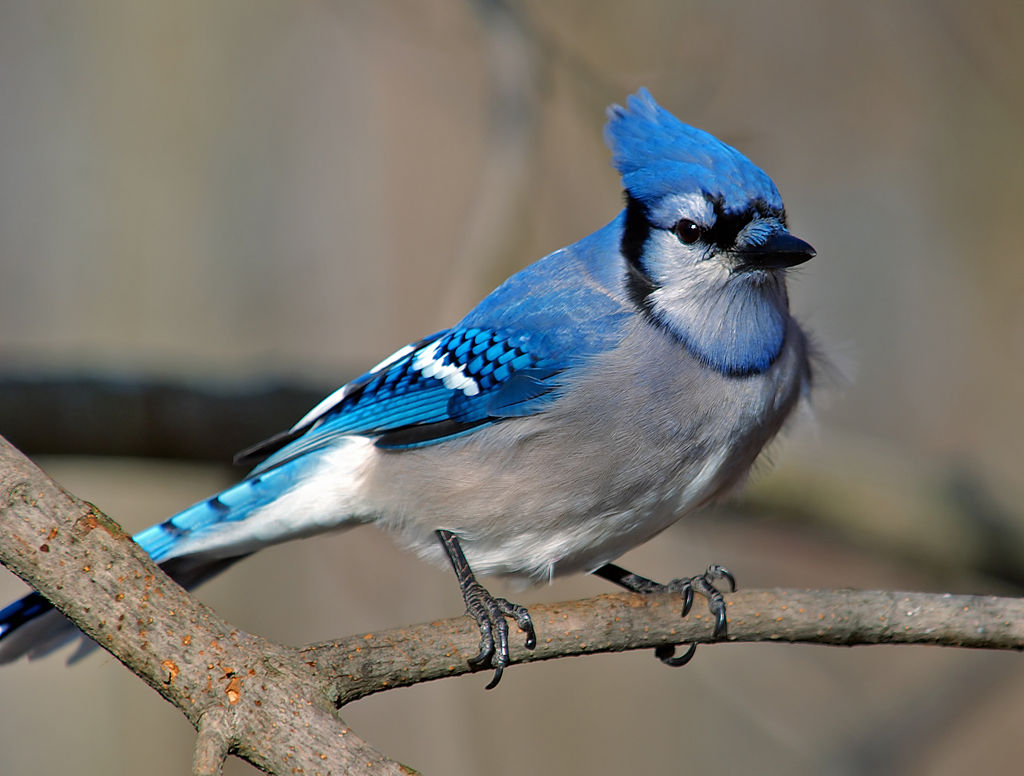
Coloration and Markings: Blue Jays have deep blue backs with long, blue wings and long, rounded tails. The wings exhibit a blue scaling pattern just below the shoulder, followed by a large, black outlined white wingbar, and with assorted large, blocky white spots outlined in black towards the centers. The tails have a more symmetrical pattern os opposing light blue squares, outlined in darker blue going down the length of the tail and this bird has white outer feathers as well. The underbelly and breast of this bird are paper white and this white carries up into the face, briefly interrupted by a black line that crosses the throat and anchors on either side at the termination of the large, light blue crest. Facially, these birds have somewhat abstract, zig-zagging black masks and they have long, stout, and straight black bills.
Size: These birds measure in at 9.8 – 11.8 inches in length and have wingspans of 13.4 to 16.9 inches wide.
Habitat: Blue Jays like to spend their time at the forest’s edge, especially if there are Oaks nearby so that they can enjoy the yummy acorns. They range out quite often, however, visiting woodlots, parks, and backyards with feeders stocked in anticipation of their arrival.
Diet: Suet and regular or striped Sunflower seeds are all you need to lure and to appease the beautiful Blue Jay.
House Sparrow – Passer domesticus

Coloration and Markings: Male House Sparrows are a mix of dark brown and tan coloration on their backs as well as their small wings and small tails. Their underbelly and breast are a ‘dirty gray’ color, with heavy dashes of black on the upper breast, coming down from the bird’s black bib. Facially, aside from the bib (which is thin, only covered the chin and throat), this bird has white cheeks and white at the base of the neck, with a rich, brown eyeline that starts black in front of the eyes but is brown as it passes behind, where it curls around nicely to frame those white cheeks. The identification of the male is completed with the notice of the gray stripe down the middle of the head and this bird’s short, stocky conical black or black and tan bill. Females will have a much lighter coloration which includes a thin, tan eyestripe rather than the complex facial markings of the male.
Size: These birds measure in at 5.9 – 6.7 inches in length and have a wingspan averaging between 7.5 to 9.8 inches.
Habitat: House Sparrows turn their bills up at the forest, preferred to live close to humans. You can find them hopping for handouts at zoos, raising farm feedlots, or on a city sidewalk, all with about the same frequency. They love backyard feeders so be sure to leave a little something out for these cute little Sparrows.
Diet: Seeds and grains are the key to this Sparrow’s heart, try a mix of wheat, rolled oats, and hulled Black Oil Sunflower seeds and you might just make a new friend.
Mourning Dove – Zenaida macroura
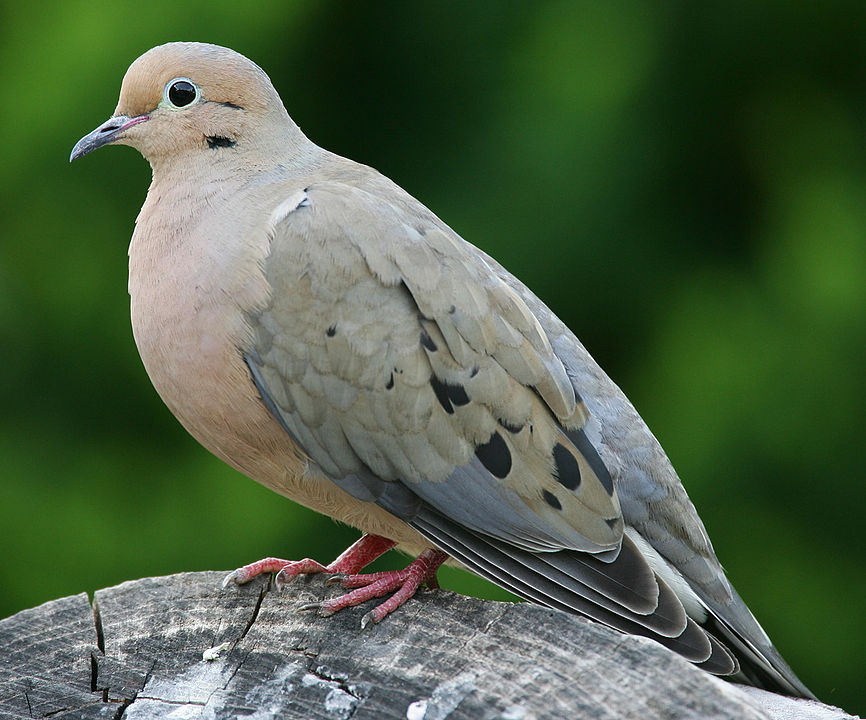
Coloration and Markings: Mourning Doves have gray backs and large, gray wings which have a light brown or tan coloration concentrated towards the centers. You will also see some large, distinctive black spots at this portion of the wings as well. They have long, thin, and point tails and the underbelly and breast of this bird are a creamy tan color with flecks of white poking out at the edges. Facially, this bird will have the most light-brown or tan color and this helps to bring out a thin, white eyering. These birds also have thin, medium-length black bills.
Size: These birds measure in at 9.1 – 13.4 inches in length and have wingspans of approximately 17.7 inches wide.
Habitat: Open areas such as fields or even large chunks of land lacking vegetation are all places where you might spot a Mourning Dove. They are common in cities as well, taking walks on the sidewalk or watching you from the fence and they are frequent visitors to well-stocked backyard feeders as well.
Diet: White Proso millet and cracked corn are tried-and-true favorites of the Mourning Dove, but for best results you should use a ground feeder and sprinkle a little seed around the base.
Pine Siskin – Spinus pinus

Coloration and Markings: Pine Siskins are brown streaked all over their bodies, with long wings and short notched tails. On the wings and tails there is a healthy dose of yellow towards the edges and the wings have a small and larger yellow wingbar present. The underbelly and breast of this bird are a dirty white with brown streaks and a thin line of yellow underneath the wings and facially there is also heavy streaking with white or sometimes yellow around the eyes and sometime yellow is present at the back of the head. These birds have small, but stout brown bills with a noticeable curve on the lower bill and a milder one on the upper.
Size: These little birds measure in at 4.3 – 5.5 inches in length and have wingspans of 7.1 to 8.7 inches.
Habitat: Pine Siskins love Evergreen and Evergreen/deciduous mixed woods, but you can also find them frequently in overgrown fields and parks, just look to see if there is scrub or brush cover nearby and this is where you’ll typically find them. They do visit backyards so be sure to leave out something tasty and you might just make a new friend.
Diet: Nyjer thistle and White Proso millet, either mixed or individually served, can attract and potentially keep the attentions of a Pine Siskin.
House Finch – Haemorhous mexicanus
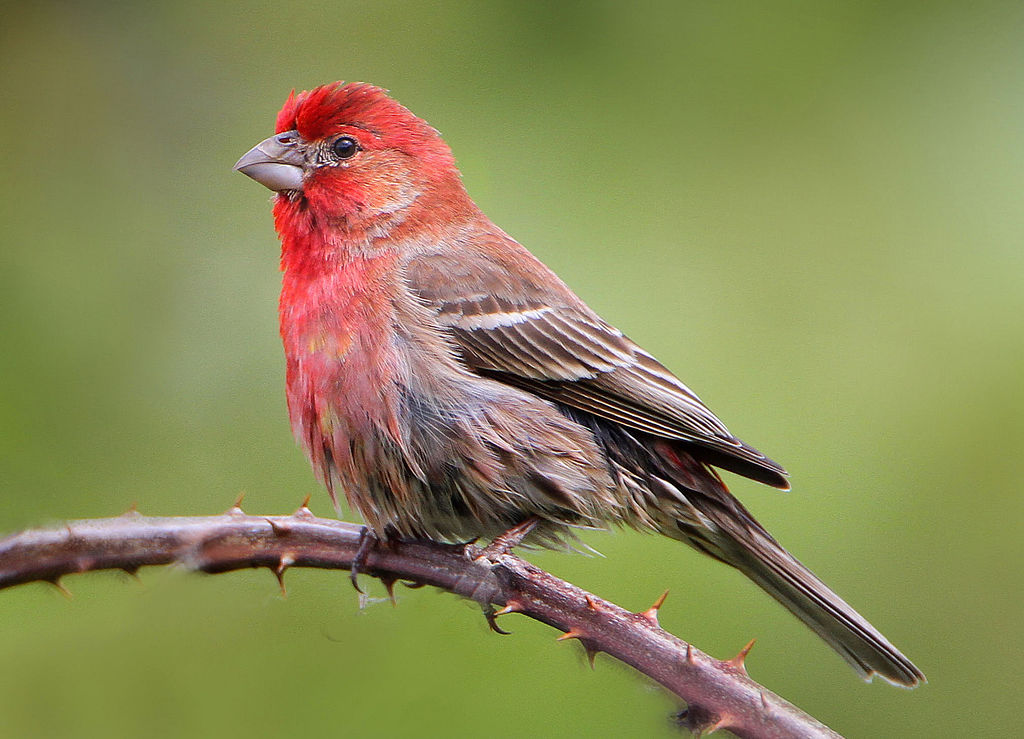
Coloration and Markings: Male House Finches are quite lovely, with gray backs and small wings and long tails, all streaked with dark brown to black. You will notice 2 white wingbars on each wing and white edging on the tail and the underbelly of this bird is white with dark brown streaks and a concentration of red that builds up to take up most of the breast. Facially, these birds have gray faces with a red throat and red cap and a gray eyeline goes from the back of the head and curls around to frame the cheek while also splitting off to go to the back of the neck. These birds have short, stocky gray bills with a small curve to them. Females will lack the red coloration and facial markings, and also display a more blurred streaking at the breast.
Size: These birds measure in at 5.1 – 5.5 inches in length and have wingspans of 7.9 to 9.8 inches
Habitat: These little birds get around, frequenting places like the forest’s edge, chaparrals, weedy fields, and even desert washes. They are happy to visit backyard feeders as well so keep them in mind when you stock up on snacks.
Diet: White Proso millet and Nyjer thistle are both known to attract this bird. Try them singly or mixed and see what happens when the Finch takes notice!
Supporting cast (Other Backyard Birds of Connecticut that might pay you a visit)
While they didn’t get the front page space, these ‘Supporting cast’ birds are bonus members of our birding roster that are available year-round and happy to visit well-stocked feeders, provided that you’ve done your homework and know what they like to eat. See if you can spot one of these Supporting cast birds this year:
- Downy Woodpecker
- American Goldfinch
- European Starling
- Song Sparrow
- Gray Catbird
Downy Woodpecker – Picoides pubescens
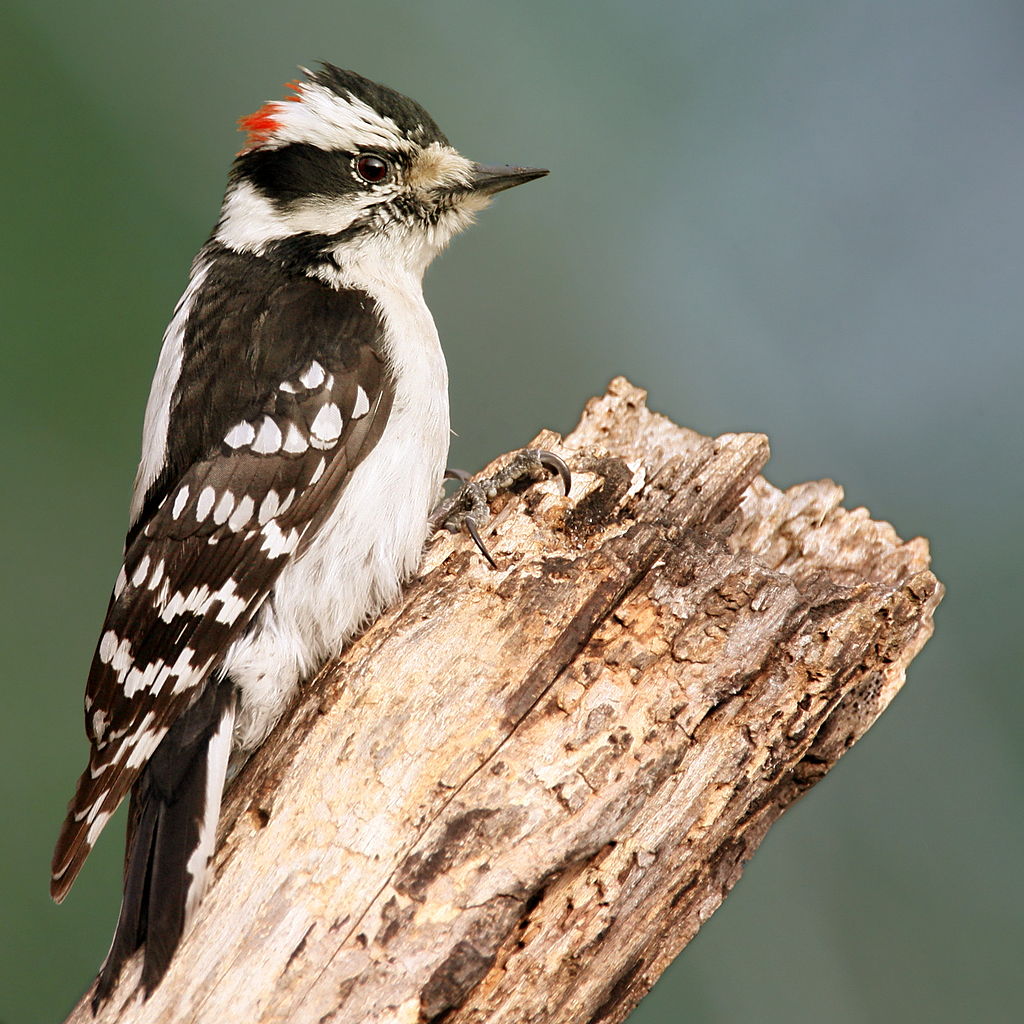
Coloration and Markings: Downy Woodpckers have a large, white stripe going down their backs with large, black wings and short, notched black tails. The wings will exhibit some striping below the shoulders, made up of blocky white spots that give the wings a bit of a striped-checkerboard look. The undersides of the tail is white, as is the underbelly and breast, and facially, this bird is mostly white except for a few exceptions. These exceptions are a black mustache line, a black bandit mask, and a thin, black cap from the forehead to the back of the mask. If the bird is a male, it terminates close to the mask with a red spot, but if it’s completely black then you are looking at a female Downy. These birds have thin, straight, and medium length black bills.
Size: These birds measure 5.5 – 6.7 inches from head to tail and have wingspans of 9.8 to 11.8 inches, making them the smallest North American species of Woodpecker.
Habitat: Downies like open woods, preferably deciduous, but they also range out into parks, empty lots, and backyards. Weeds and shrub cover also attract these birds, so keep an eye out and you might just spot one of these cute little Woodpeckers.
Diet: While these birds will eat a lot of different foods, their absolute favorite feeder food is suet, followed closely by the sugar water in your Hummingbird feeder!
American Goldfinch – Spinus tristis

Coloration and Markings: Male American Goldfinches have bright yellow backs with long, black wings and short, notched tails. They display 2 white wingbars on each wing and some vertical white marking towards the inner-area of the wing and on the tail as well. The rump of this bird is white but the underbelly and breast will be bright yellow, like the bird’s back, and facially we have bright yellow as well. The two exceptions to this are the bird’s small, black forehead-cap and a medium-length, conical orange bill. Females display olive coloration instead of the black and present somewhat muted yellow colors and in the winter both genders assume a brown coloration, though the wingbars are still dimly present on the dark wings.
Size: These little birds measure in at 4.3 – 5.1 inches in length and have wingspans of 7.5 to 8.7 inches.
Habitat: Goldfinches love overgrown, weedy fields, especially those which are prone to flooding. You can also spot them in gardens, orchards, and the occasional backyard as well.
Diet: Nyjer thistle and hulled Black Oil Sunflower seeds are all that you need to make the American Goldfinch a very happy bird.
European Starling – Sturnus vulgaris
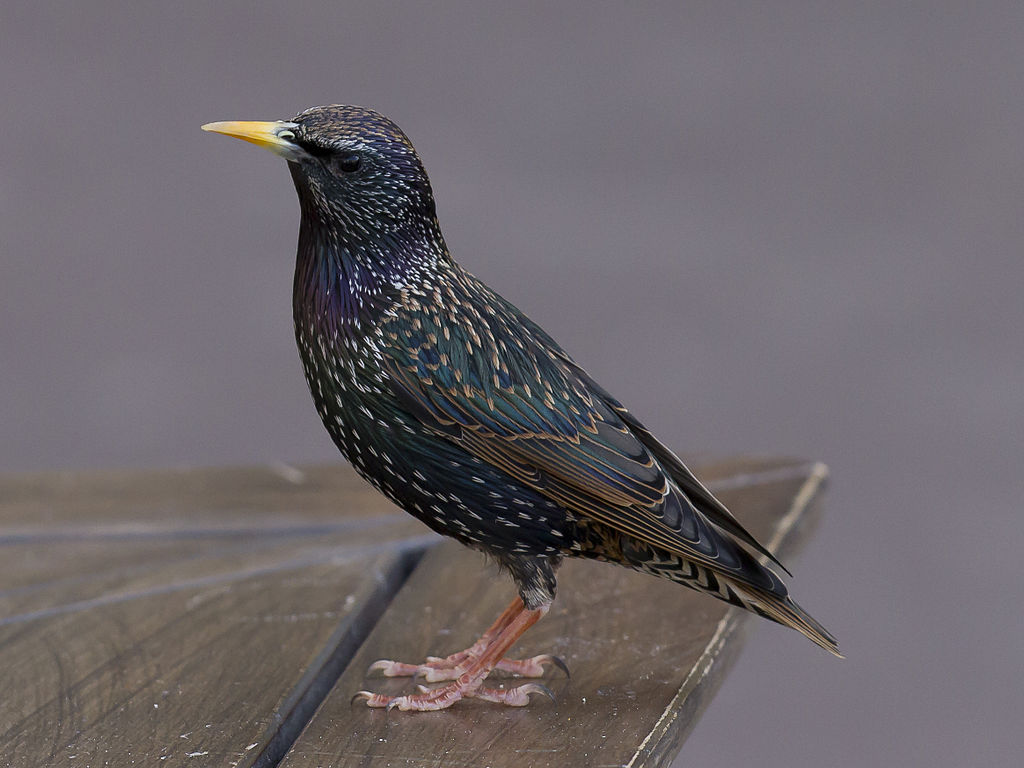
Coloration and Markings: European Starlings look like yellow-billed Blackbirds from a distance but when they are closer you can see that their coloration is a shimmery mix of purples and greens. They have medium-length wings and short tails and facially, you can’t miss their long, stout, and straight yellow bills. In the winter, things get interesting when Starlings molt into their new plumage, which is brown with lovely white spots. Keep an eye out this winter and you can see for yourself!
Size: Starlings measure in about the same as a Robin, being 7.9 – 9.1 inches long and having wingspans of 12.2 to 15.8 inches wide.
Habitat: These are farm and city birds, who ignore the forest in lieu of the fruitful foraging available whenever people are around. Look for them just about anywhere around the city and you will find them.
Diet: These birds love suet and might become a bit of a pest in this regard, gobbling it all down and leaving none for the other birds. If this occurs you can obtain Starling-proof feeders to protect the suet and appease them with some wheat, rolled oats, and hulled Sunflower seeds of any kind.
Song Sparrow – Melospiza melodia
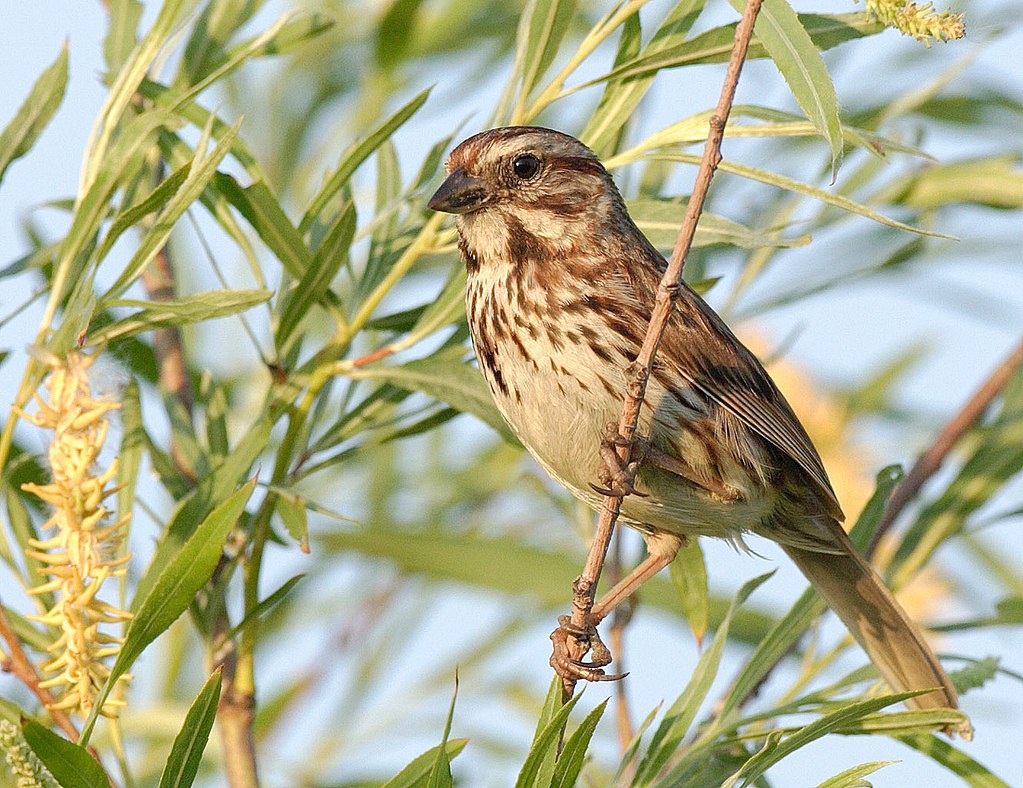
Coloration and Markings: Song Sparrows have gray backs with heavy streaks of warm, brown color. They have short wings and long, perky tails, with the wings often sporting gray wingtips but being mostly brown overall. The underbelly and breast of this bird are gray with brown streaks as well and facially, this bird has a mostly gray face with the exception of a brown stripe underneat a white mustache line as well as a brown eyeline going to the back of the head and a thin, brown cap. These birds have short, conical silver bills.
Size: These birds measure in at just 4.7 – 6.7 inches from head to tail and have wingspans of 7.1 to 9.4 inches wide.
Habitat: Song Sparrows love open wooded areas, especially with water nearby, but they frequent a diverse collection of places. You can spot them in marshes, desert washes, weedy fields, and in backyards throughout the city.
Diet: White Proso millet, crushed peanuts, and wheat are all favorites of the Song Sparrow so be sure to leave a little out to let them know that you are thinking of them.
Gray Catbird – Dumetella carolinensis

Coloration and Markings: Gray Catbirds have stone-gray backs, with broad, medium-length wings and long, rounded tails of the same color, though darkened a bit on the tail. On the undersides of the tail you will see black and gray as well as a foxy red-brown spot at the rump while the underbelly and breast of this bird are back to stoney-gray. Facially, this bird is gray as well, with the exception of a small black cap that has jagged bottoms like a tiny hairpiece and this bird has a straight, narrow black bill with a slight curvature present on the upper bill.
Size: These birds measure in at 8.3 – 9.4 inches from tip to tail and have wingspans of 8.7 to 11.8 inches wide.
Habitat: These birds are attracted to smaller trees with brushes, brambles, thickets, and thorns. Aside from frequenting these places you can also find them close to streams and in overgrown fields as well.
Diet: Grape jelly, halved-oranges, and chopped apples are all effective lures for attracting and possibly keeping the attentions of the Gray Catbird.
Connecticut Bird Buffet
Today we’d like to share some of our tips as well as some we’ve gleaned from the Connecticut Audubon, who have a lot to say on the subject. If you’d like to check out their article then be sure to visit our reference links and you can see it in its entirety. In the meantime, we’ve got a list of foods that you will want to have available in your feeder to help to ensure that the most diverse collection of visitors will look upon your feeders fondly. Try adding one or more of these items:
- Nyjer thistle
- Whole, shelled or crushed peanuts
- Dried apricots or other fruits
- Black Oil Sunflower
- Grape jelly
- Orange halves
- Safflower seeds
- Crunchy peanut butter
Connecticut Birding Hot Spots
The Chirparazzi know all the good spots for taking photos and catching glimpses of the winged wonders of many a state and Connecticut is no exception. We’ve collected some birding hotspot locations from around the compass points as well as central Connecticut and any one of them is well worth the visit. When you have a little time to yourself, why not live a little and pay the local birds a visit. Just don’t forget to bring a sack lunch and your binoculars when you visit one of these locations:
- Northern hotspot – Bloomfield Greenway Multi-Use Trail
- Eastern hotspot – Moosup Valley State Park Trail
- Southern hotspot – Shoreline Greenway Trail
- Western hotspot – New Milford River Trail
- Central hotspot – Hanover Pond Trail
Detailed descriptions of each location as well as information regarding visiting and what birds you can see at these locations may be found at https://www.traillink.com/stateactivity/ct-birding-trails/
In Summary
We hope that you’ve enjoyed our little foray into the wonderful world of birding in the Constitution state. Connecticut has quite the scenic environment, so why not take advantage? Get yourself plenty of photos to share and make a day of it with the family. Who knows, you might make a few new birders in the process! Until next time, happy Birding!
